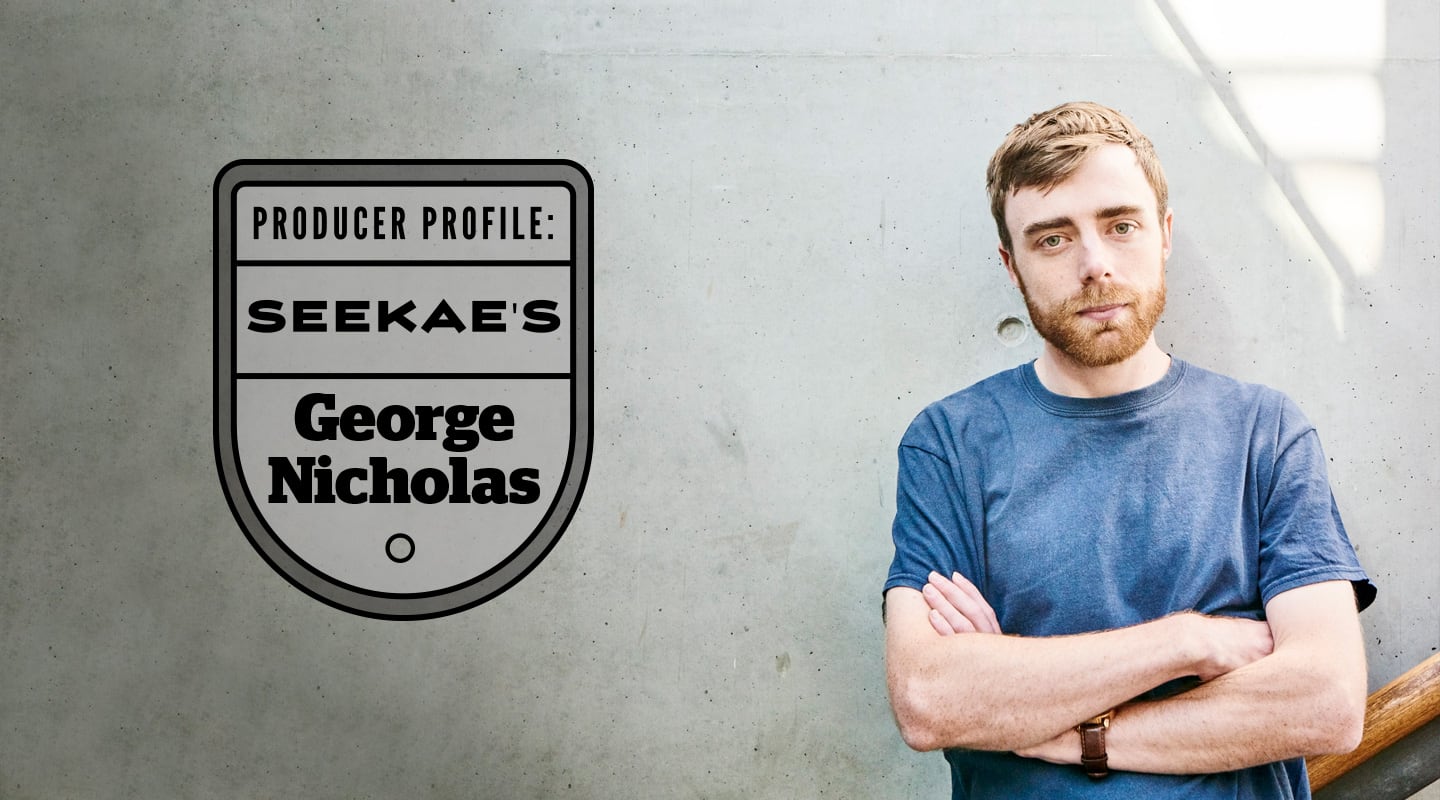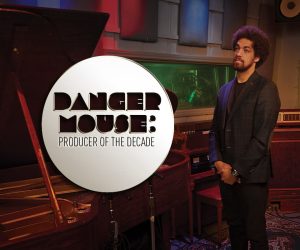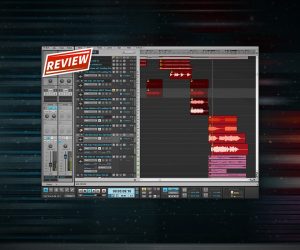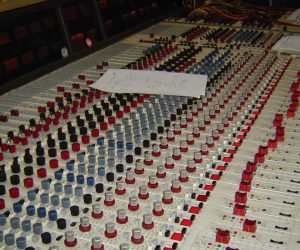
Producer Profile: Seekae’s George Nicholas
Nicholas talks about how mixing indie electronic music is all about distinguishing the intentionally weird from the byproduct of bedroom studio screw-ups.
Feature Photo: Kyle Ford
Tucked in behind FBI radio station, producer George Nicholas might as well have a pipeline from his studio to the airwaves. One third of electronic act Seekae and half of Cliques, he’s quickly establishing himself as a go-to producer and mixer for the rest of Australia’s electronic music scene.
Lately he’s been working on a modern soul funk debut for Winston Surfshirt, and a record for their Sweat It Out label mates, Polographia. Nicholas has also had a hand in the new record Lovers by Virgin EMI-signed George Maple — who debuted with the Flume-produced hit Talk Talk in 2014 — and mixed Treetops from Cloud Control’s latest record Zone (see Issue 124 for the full story).
Because he mixes a lot of programmed music, a big part of Nicholas’ approach is giving electronic sounds a sense of air and space. Winston Surfshirt is a classic example, with completely programmed drums and a generous helping of virtual instruments. Nicholas said he goes to great pains to “make songs sound less like Ableton by obscuring the source. The reality might not be as romantic as some dude sitting at a Rhodes singing his heart out in a log cabin. Oftentimes it comes from a Kontakt Rhodes preset that’s been drawn in by hand. I like to bring more life into it; the illusion of a spatial dimension that might not have existed before. Using equipment that’s not the stock Ableton gear helps.”
The obvious go-to is reverb, but Nicholas also likes to add colouration with tape saturation plug-ins and outboard gear, as well as infusing a sense of depth with Ableton’s resonator. “I use the RE-20 Space Echo pedal, but that’s probably it as far as hardware reverbs,” said Nicholas. “I just got the modulating reverb plug-in Modnetic from Surreal Machines, and I use a lot of impulse responses. I use the Ableton resonator and a few filter banks from Native Instruments. Resonators allows you to tune the sense of space; creating a space that rings a certain amount.”
AudioTechnology: What’s the hardest part about mixing electronic music?
George Nicholas: Making judgement calls about the intention of the artist. I get sessions from producers who’ve carefully selected each snare drum sound. If there’s any noise in it, it’s probably supposed to be there. If these choices already exist within the session, it’s because they selected them.
Because all those choices happened before you get your hands on it, it’s more important to figure out which weird and unconventional parts in the song are unintentional flaws, and which are put in there to make it sound interesting and give it a certain vibe. Sometimes they don’t know what they’re doing and screwed it up, but oftentimes they do want the kick drum to have no sub bass, or the snare to be 10dB louder than everything else.
AT: Do you generally find it easier or harder to mix programmed music or music recorded with acoustic instruments?
GN: Most of the time electronic or programmed music is easier to mix because they haven’t recorded some crappy drum kit with three 57s and expected you to do all the work. You don’t have to spend all that time at the start getting it to a listenable level. It’s about making it a bit better and not trampling on all the hard work that’s got them to that point. A lot of times that means just extending it, bringing out things in the high frequencies and getting the low end to work better. A lot of work goes into getting the vocals to sit right, which is hard. It’s on a track by track basis. Sometimes it’s about adding loads of colour and delay throws, and other times it’s about making everything a bit clearer and leaving it at that.

AT: You’re working on an upcoming Seekae record; the first was instrumental, then you surprised everyone by adding Alex’s vocals to the last, do you guys have a central vision for the new record?
GN: Not really. We all live in different places — John is in the UK, Alex is in Berlin — and all listen to totally different music. Three months ago we decided to get together for a couple of weeks in the UK, because writing on the internet can only go so far. We all came with different ideas of where we wanted to take it and mushed together a hybrid of those three perspectives. Seekae is always going to sound like at least three different things because we’re all writers for it.
AT: How does the internet songwriting process work?
GN: It’s very disorganised. We send MP3 links attached to emails and phone voice memos; it’s not some sophisticated cloud sharing program. We give each other feedback, but the person who wrote the track will tend to take responsibility for the production, up until the last point when we come together.
AT: Do you worry about what the other guys are going to say when you send a demo through?
GN: Yeah, of course. That’s the great thing about having people you write with and a community around you. It’s the pride you get in showing something they like, but mostly it’s the shame you feel if it’s not good enough and you can tell they’re not into it. Restrained positivity — a Larry David, ‘meh’ — is usually an indication it’s no good.
AT: Then what happens when you get together?
GN: We usually flip sessions between computers. The whole approach where everyone’s standing behind one person, looking over their shoulder and pointing at the screen telling them what to do is never really conducive for creating interesting material. You can easily get caught up in the moment, and hype each other up. Whereas you’ll exercise more of a critical ear when working by yourself. It’s a great starting point to think everything’s s**t and you’re s**t, and you’re desperate to make it better.
AT: Do you work exclusively in Ableton?
GN: We’re all in Ableton for Seekae, but I do all my mixing in Pro Tools, and I do a bit of production in Pro Tools as well. For writing, I do everything in Ableton, because it’s so fast. I also like to keep those two things separate. If you start mixing too much in Ableton, or start producing too much in Pro Tools, you get too technical when you should be writing, and too creative when you should be mixing.
I like to bring more life into it; the illusion of a spatial dimension that might not have existed before

AT: What are some of your favourite sounds at the moment?
GN: In Australia, we can’t get away from detuned saw waves and everyone’s got a DSI Prophet 8. For bass I love a warm, saturated Moog or a Fender P bass, though I wish I could play it better.
I use the Arturia ARP 2600 a lot for pads. You can use the plug-in version in poly mode, and I love the way it sounds with the reverb on it. I either use that, or the Yamaha CS-80V emulation, or my Korg PolySix hardware synth. Something that warbles and sounds good, with loads of reverb. A lot of the time I don’t incorporate any dry sound.
If it’s a lead, it’s probably a high complement to the bass line on the Polysix. Partly due to laziness, but you also get a nice call and response. If I’m working with a vocalist, I let that be the lead. I don’t like to put too much stuff in that range where the voice is.
AT: Do you have a mile-long drum sample collection?
GN: I’m a fiend, I’ve collected so many drum samples. I’ve made a conscious effort to listen through and curate the samples when I get them. I put them into Ableton drum racks, so it doesn’t become a process of finding a kick drum and scrolling through a list of a thousand options. Three hours later you forget the song you’re making, and you’ve also got the fattest, fullest kick drum that drowns out the whole mix. I have a few I really know well so I can preview them in a mix and see if they work. Rather than going out into finder and finding the behemoth, which the bass never likes. LinnDrum samples are probably my thing at the moment. They’re just so thick and rich, yet short. That and the CR-78.
AT: How do you approach your mixes?
GN: I like to work on different projects at the same time, it helps inspire creativity and has the side effect of letting me work at my own pace. When you’re in the same room as the client, you don’t take the same risks. You don’t listen to that piece of music you were thinking of in your head because you don’t want them to think you’re ripping off the mix from another track. Or try something that probably won’t work because you’re attempting to appear ‘professional’ and efficient. Whereas, when you’re on your own you try crazy things and take your time with it.



























RESPONSES